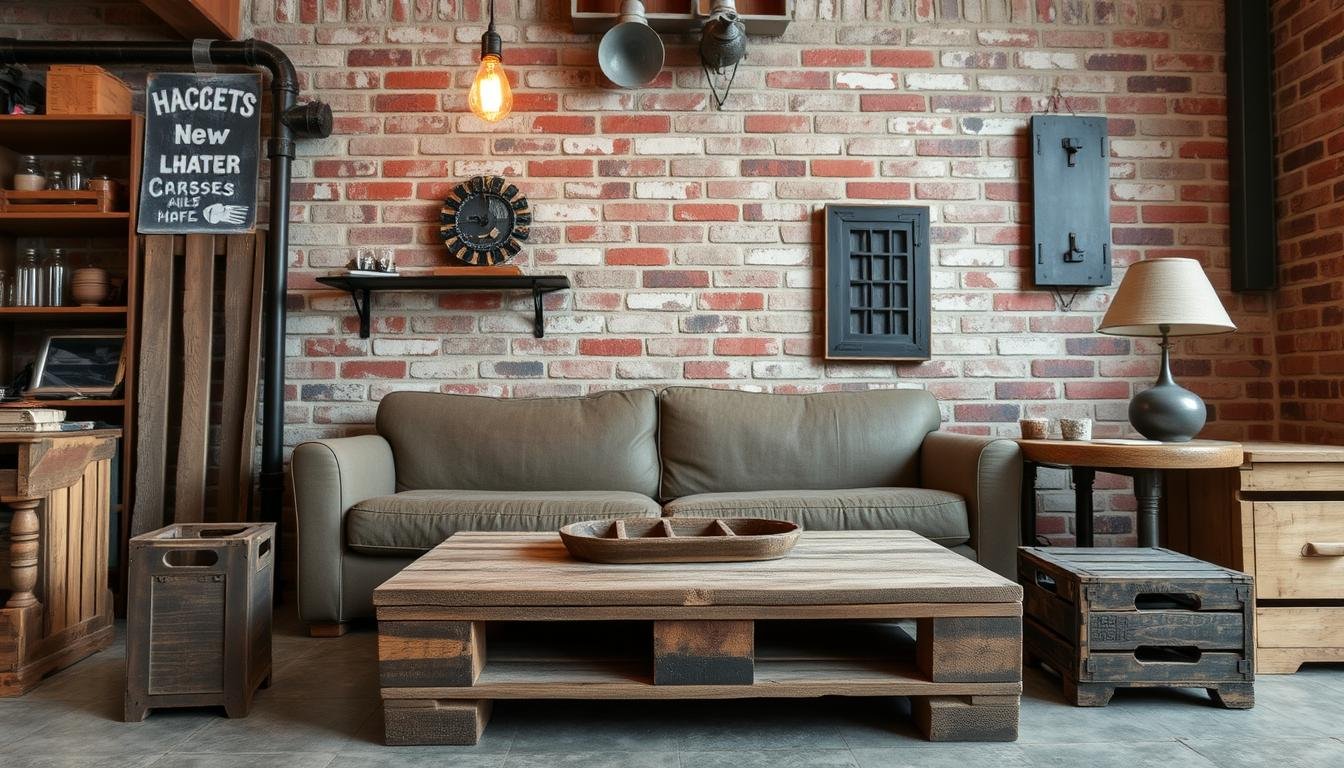Some links on this page are affiliate links. This means we may earn a commission at no additional cost to you if you click through and make a purchase. Thank you for your support!
Imagine turning old factory parts and vintage machinery into a stunning, eco-friendly interior. Welcome to the world of industrial decor, where old and new come together beautifully. This style is all about style and sustainability. So, how can you use repurposed elements to create a unique and stunning industrial-inspired space?
Basin Harbor Club Resort and HMC Advertising show us the endless possibilities of upcycling. In this article, we’ll explore the origins of industrial aesthetics and its environmental benefits. We’ll also cover the tools and materials you need for upcycling projects. Get ready to see the hidden potential in everyday objects and turn your space into a unique industrial oasis!
Understanding Industrial Decor Aesthetics and Sustainability
The industrial style has grown from its rough factory beginnings to a popular choice for homes and businesses. It’s not just about looks; it’s about reducing waste and saving resources. It also brings unique stories and character to any space.
Innovative designers are leading this change. They turn old materials into functional, stylish pieces.
Origins of Industrial Style
The industrial style started in the late 19th and early 20th centuries. Factories and warehouses used materials like metal, wood, and concrete because they had to. Over time, people started to see the beauty in these raw materials.
Today, industrial design is all about being green. It uses eco-friendly crafts and reduces waste.
Environmental Impact of Repurposed Decor
Industrial designers are key in the upcycling and repurposing movement. They use materials that would otherwise be thrown away. This not only saves resources but also cuts down on energy and carbon emissions.
Modern Interpretations of Industrial Design
Today’s industrial design is a mix of old and new. It keeps the heavy industrial feel but adds a modern, minimal touch. Designers mix raw materials with sleek, streamlined pieces.
This creates spaces that are both useful and beautiful. It’s a unique, sustainable way to decorate.
“Industrial designers play a crucial role in transforming discarded items into valuable, functional pieces that preserve materials and add character to spaces.”
Essential Tools and Materials for Upcycling Projects
Are you ready to start an exciting upcycling journey? You can turn old items into beautiful home decor. To do this, you need the right tools and materials. Let’s look at the essential items for your DIY projects and embracing the circular economy.
First, you’ll need a reliable jigsaw. An entry-level model is perfect for upcycling. Make sure to have at least 2 sturdy clamps for safe and precise cuts. A strong drill with different drill bits is also crucial. It helps with drilling holes and assembling your projects.
Being versatile is important. So, get a screwdriver set that can handle many screws and fasteners. An electric detail sander is great for fine sanding. Foam and microfiber rollers will help you get a professional paint job.
| Tool | Purpose |
|---|---|
| Jigsaw | Cutting curves and intricate shapes in upcycled projects |
| Drill | Drilling holes and assembling upcycled pieces |
| Screwdriver Set | Versatile fastening and disassembly tasks |
| Electric Detail Sander | Achieving a smooth, refined finish on upcycled items |
| Foam/Microfiber Rollers | Applying paint and finishes evenly on upcycled surfaces |
Remember, you’ll also need a paint scraper for removing paint, paint stripper for furniture, painter’s tape for clean edges, and Selley’s Liquid Nails for strong adhesion. A ready-mix multipurpose filler is useful for filling holes or cracks.
With these tools and materials, you’re ready to create amazing, unique pieces. They will show off your creativity and support the circular economy. Start upcycling and make your home beautiful with a mix of old and new!
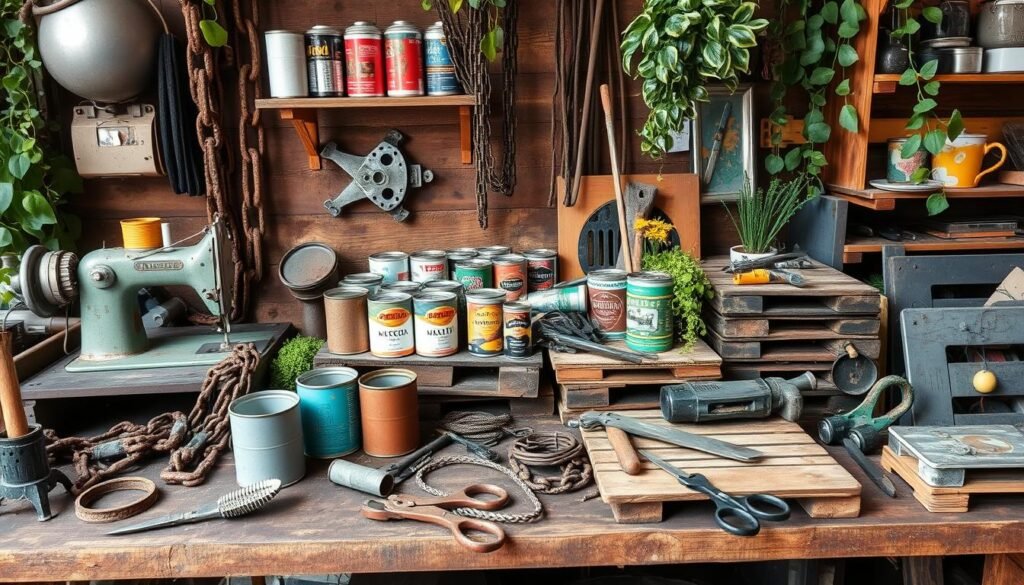
Repurposed Materials in Modern Interior Design
Modern design loves using old materials in new ways. This makes homes look unique and helps the planet. You can find special items and make them part of your decor. This way, you add character and care for the environment at the same time.
Selecting Quality Salvaged Items
Finding the right old materials is the first step. Look in flea markets, antique shops, and construction sites. You’ll find things that can become beautiful or useful again. Choose items that are strong, not damaged, and can be fixed or changed.
Preparation and Cleaning Techniques
- Check each item for damage, harmful stuff, or bugs.
- Clean them with safe, green cleaners.
- Sand or refinish them to make them shine again.
- Cleaning right keeps your items safe and looking good.
Safety Considerations
When working with old materials, safety comes first. Wear gloves and goggles to protect yourself. Sanding or refinishing needs good air to avoid breathing in bad stuff. With safety steps, you can make your finds beautiful and safe for your home.
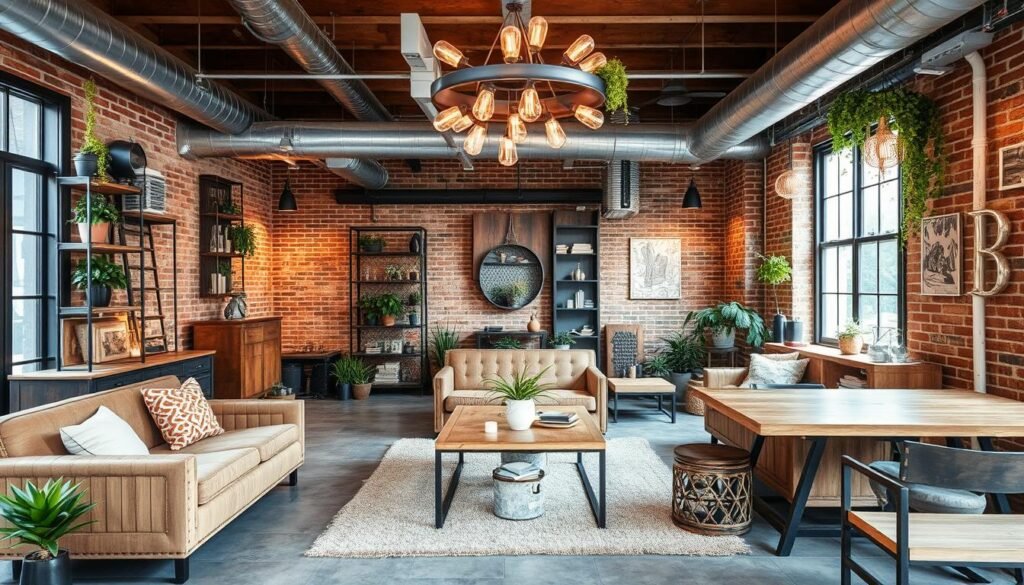
“Repurposing materials not only gives them a new life but also reduces waste and environmental impact. It’s a win-win for both the homeowner and the planet.”
Transforming Vintage Industrial Elements
Get ready to unleash your creativity! We’ll explore exciting ways to transform vintage industrial elements into stunning decor pieces. From repurposing old machinery parts into unique coffee tables to turning vintage signs into wall art, the possibilities are endless. Learn how to blend these reused items seamlessly into your existing decor for a cohesive industrial look that celebrates eco-friendly materials.
One captivating example is the Office Project in Beijing, where a team of designers converted a former factory building into a breathtaking home, studio, and gallery for a calligraphy artist. They used bright, open spaces to showcase the building’s industrial heritage while creating a welcoming and sustainable environment.
Another inspiring project is 5Lmeet no.88 in Beijing, a mixed-use space that was transformed from an abandoned soy sauce factory. This vibrant hub now houses restaurants, a bookstore, offices, and apartments with ultra-compact living spaces, all within the original industrial structure.
| Project | Location | Transformation |
|---|---|---|
| Office Project | Beijing, China | Converted a factory building into a home, studio, and gallery for a calligraphy artist, emphasizing bright, open spaces. |
| 5Lmeet no.88 | Beijing, China | Transformed an abandoned soy sauce factory into a mixed-use space with restaurants, a bookstore, offices, and apartments. |
| Ricardo Bofill’s Residence | Spain | Converted a cement factory with over 30 silos into a surrealist palace surrounded by greenery. |
| Roskilde Festival Folk High School | Denmark | Turned a former concrete factory into a creative school setting within an existing building. |
| ProMedica Headquarters | Ohio, USA | Housed in a 120-year-old steam plant, revitalizing Toledo’s downtown area and showcasing a history-infused waterfront setting. |
These inspiring projects show the endless possibilities for transforming vintage industrial elements into stunning, eco-friendly living spaces. By embracing green living and conscious consumerism, we can breathe new life into old structures. This creates beautiful, functional homes that celebrate the industrial aesthetic.
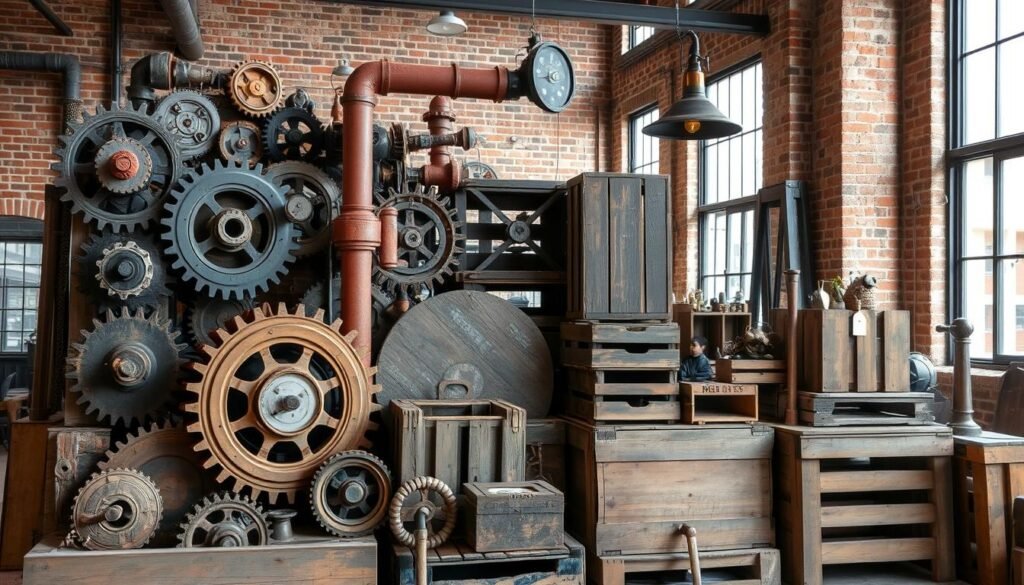
“Adaptive reuse of old buildings preserves industrial style and historical value.”
From repurposed wood beams and exposed brick walls to reclaimed steel and concrete, the materials that define industrial design can be seamlessly incorporated into modern living spaces. By blending these vintage industrial elements with contemporary furnishings and design choices, you can create a truly one-of-a-kind home. This home reflects your personal style and commitment to sustainability.
Creative Ways to Use Reclaimed Wood
Reclaimed wood is a versatile and sustainable material. It can give new life to industrial-inspired decor. From furniture to wall features and flooring, it offers endless possibilities. Let’s explore how to use it in your living spaces!
Furniture Applications
Reclaimed wood is great for making durable and striking furniture. You can turn upcycled barn wood, salvaged lumber, and discarded pallets into unique tables, shelves, and storage units. These pieces add character and show your eco-friendly commitment.
Wall Features and Accent Pieces
Reclaimed wood is perfect for eye-catching wall features and accent pieces. Create rustic-chic wall panels, shelves, or artistic installations with salvaged wood. These elements can enhance your space’s industrial vibe while highlighting green manufacturing.
Flooring Solutions
Reclaimed wood flooring adds authentic industrial charm to homes. Weathered barn wood, distressed planks, and aged lumber create a warm atmosphere. These flooring solutions add character and support environmental responsibility.
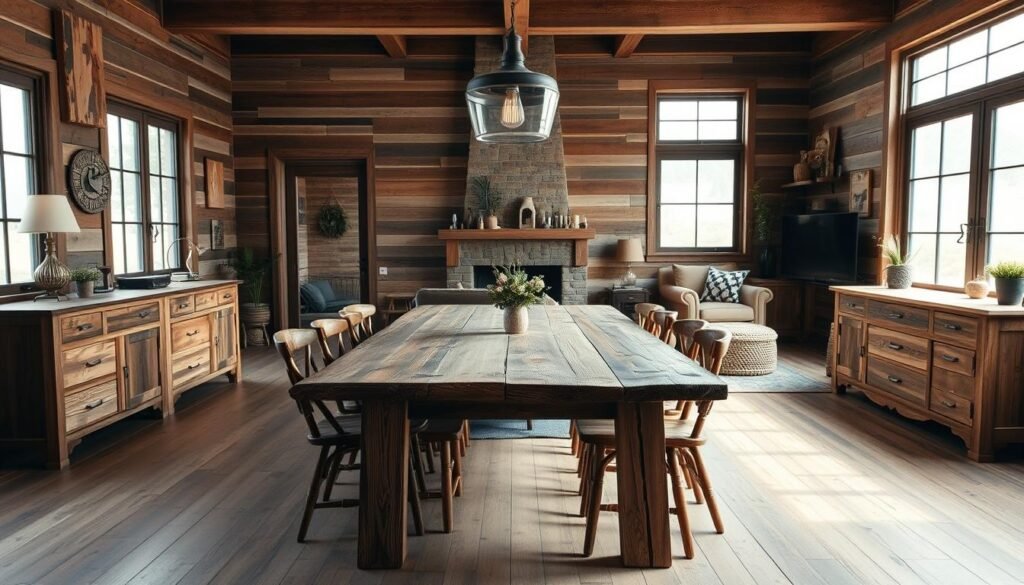
In Minnesota, reclaimed wood is popular among DIY fans, home renovators, and eco-advocates. Local salvage yards, thrift stores, and online marketplaces offer quality reclaimed wood. With creativity and basic woodworking skills, you can make stunning decor pieces for your industrial-inspired spaces.
“Reclaimed wood offers a blend of traditional and modern home designs, making it versatile for various decor styles.”
Metal and Hardware Integration Techniques
Adding salvaged metal pieces and hardware to your decor brings depth and charm. Items like repurposed gears and vintage fixtures can change a room. They show off your love for sustainable design.
Start by cleaning and restoring old metal. Use a mild cleaner or steel wool to remove rust. Always protect your hands and work in a well-ventilated area. After cleaning, apply a clear sealant or wax to keep the metal looking good. This makes your salvaged materials ready for your upcycled design.
There are many ways to use sustainable materials. You can hang gears on walls as art or turn pipes into shelves. Industrial parts can become unique cabinet pulls or decorative items.
| Metal Fabrication Technique | Common Applications |
|---|---|
| Forging | Automotive, aerospace, construction (crankshafts, gears, structural components) |
| Rolling | Sheet metal production (beams, automotive panels, industrial sheets) |
| Extrusion | Aluminum frames, pipes, tubes, profiled beams (automotive, aerospace) |
| Stamping | Automotive parts (panels, brackets, housings) |
| Bending | Structural pieces (tubes, pipes for construction, automotive, aerospace, furniture) |
| Drawing | Kitchen sinks, automotive components (panels, hoods), containers |
| Punching | Automotive parts, electronics enclosures, decorative metalwork (holes, slots, shapes) |
With creativity and the right methods, you can turn trash into treasure. These metal items become stunning pieces that show your love for sustainable design.
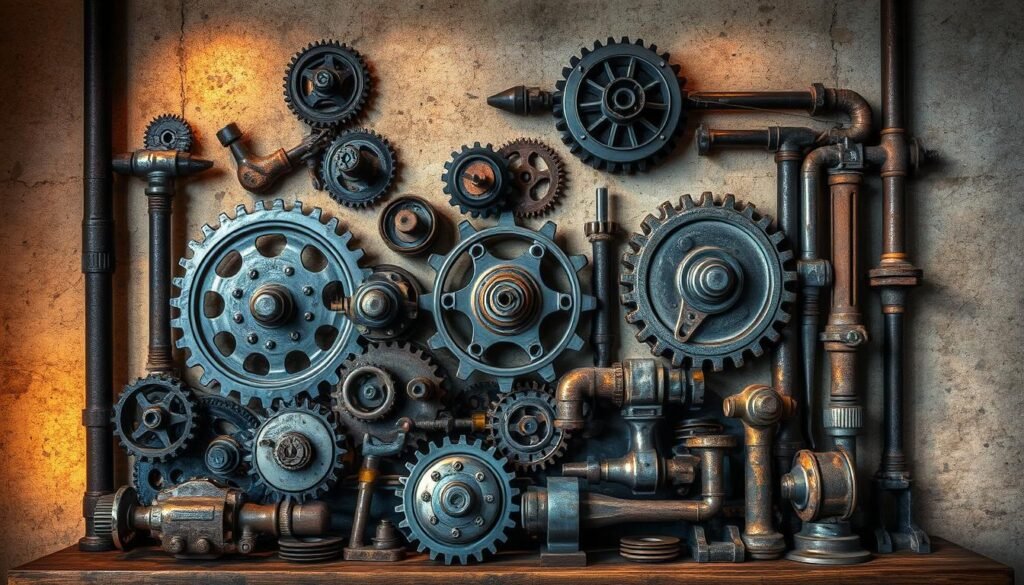
Lighting Solutions Using Salvaged Materials
Starting your industrial-inspired space with the right lighting is key. You can make unique, standout fixtures by using recycled materials. Let’s dive into pendant lights and industrial sconces made from eco-friendly products.
Pendant Light Creation
Pendant lights are a great way to show off your creativity with recycled items. Use old ropes, industrial parts, and vintage glass to make special lighting pieces. Did you know that 60% of the lighting solutions use recycled plastic like bottles and spoons? You’ll find many materials to choose from for your DIY projects.
Industrial Sconce Ideas
Give your walls an industrial look with salvaged sconces. 20% of the solutions use glass containers, showing how versatile glass jars and bottles are in lighting. Turn tin cans, fabric, and wine bottles into eye-catching sconces. These eco-friendly ideas give old items a new life and show your dedication to green decor.
Using recycled materials in your lighting can make your space both beautiful and eco-friendly. Embrace upcycled decor and let your creativity light up your industrial-inspired space.
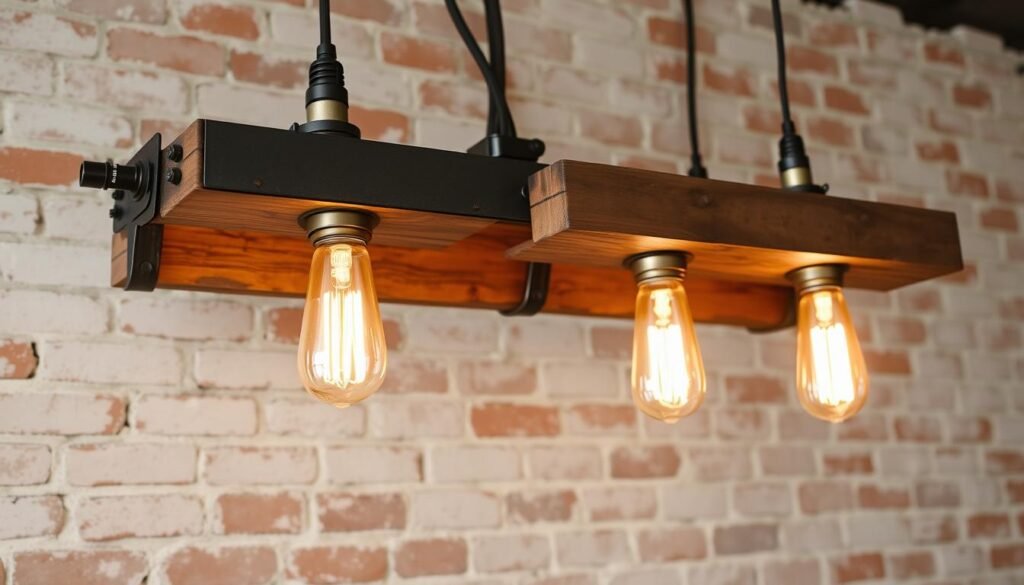
“Repurposed materials allow us to create truly unique lighting solutions that are both visually appealing and environmentally conscious.”
| Lighting Solution | Recycled Materials Used | Sustainability Impact |
|---|---|---|
| Pendant Light | Plastic bottles, plastic spoons, glass jars, fabric scraps | 60% of featured solutions involve repurposing plastic items, reducing waste and promoting eco-friendliness. |
| Industrial Sconce | Tin cans, wine bottles, glass containers | 20% of solutions utilize glass containers, showcasing the versatility of recycled glass in lighting design. |
Textile and Fabric Upcycling for Industrial Spaces
Textile and fabric upcycling is changing the game in sustainable interior design. We can turn old grain sacks, vintage flags, and industrial fabrics into something new. This way, we soften industrial decor and give old textiles a new life.
The textile industry is a big problem, with over 11 million tons of textiles landfilled every year. But upcycling offers endless creative possibilities. We can make unique upholstery, pillows, and wall hangings from old fabrics.
To make old textiles work again, we need to clean and restore them. With the right techniques, we can make them fit perfectly into our sustainable interiors and industrial spaces.
Upcycling Textiles for Industrial Spaces
Textile artists are leading the way in sustainable design. Zwia Lipkin, for example, only uses upcycled home décor textiles. She gets her materials from FabMo in California and personal connections.
Ruth Singer also focuses on vintage textiles. She uses 1930s linens from her grandparents and damaged Victorian clothing. Her work combines history and sustainability beautifully.
Elnaz Yazdani shows how versatile textile waste can be. She uses waste from factories and car parts to create her embroidery. These artists prove that creativity and innovation can turn discarded items into stunning sustainable interiors.
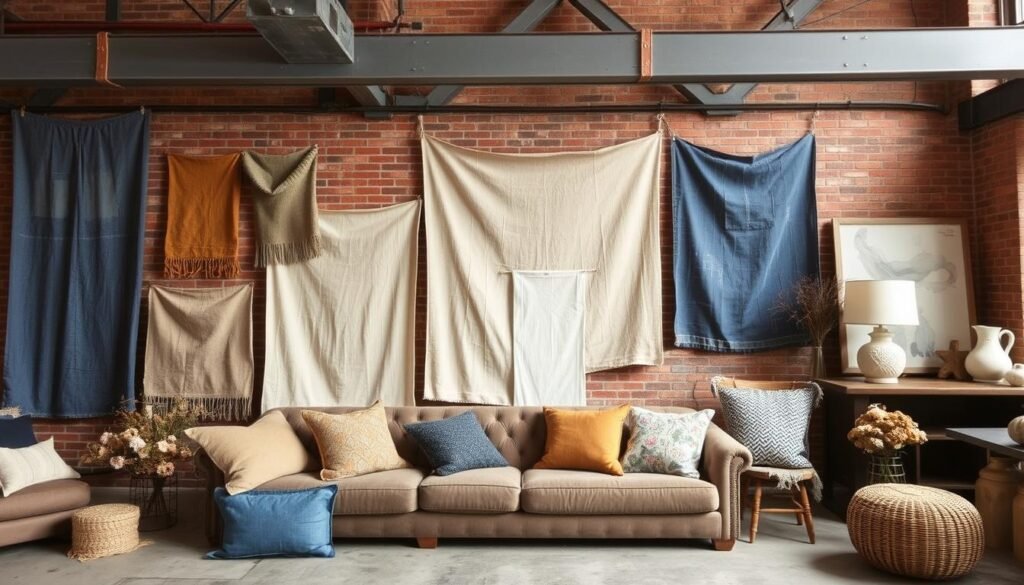
Upcycling textiles not only helps the environment but also adds warmth and character to industrial spaces. We can make cozy furniture and eye-catching wall hangings from repurposed textiles. It’s a great way to make any room more sustainable.
Storage Solutions with Repurposed Items
Turning everyday items into useful and stylish storage is key to creative reuse. At the heart of industrial decor is the love for reclaimed materials. This mindset helps organize your living spaces in new ways. From repurposed shelving to custom systems, the options are endless with an inventive approach.
Shelving Systems
Industrial-inspired shelving adds rugged charm to any room. Give old lockers, wire racks, or metal shelves a new look with paint or keep their weathered look. Vintage crates and wooden pallets also make great, DIY shelving units with rustic flair.
Choose salvaged materials that fit your industrial style. This way, your shelves will look great and match your decor.
Organization Units
Storage needs both function and style. Repurposed items are perfect for organizing, like upcycled cabinets and drawers. Use reclaimed wood, metal, and fabric to make custom units that save space and add personality.
Think creatively – an old ladder can display towels or books, and a vintage steamer trunk can be a stylish coffee table with hidden storage. Repurposed storage blends form and function beautifully. By using reused resources, DIY projects, and creative reuse of reclaimed materials, you create systems that meet your needs and enhance your industrial decor.
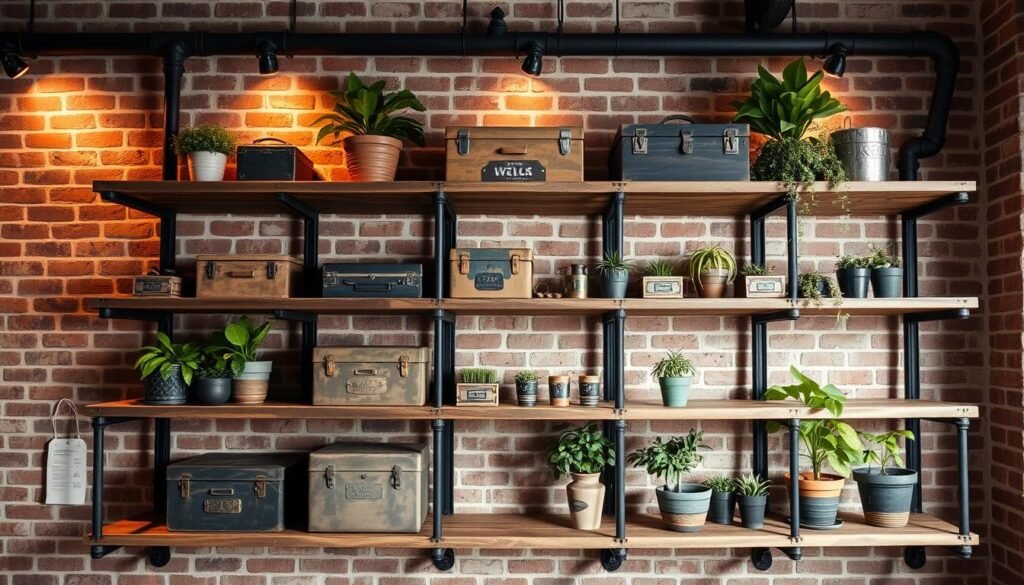
Color Schemes and Finishes for Industrial Decor
Creating an industrial-inspired space means choosing colors that match its raw look. A neutral base of grays, blacks, and whites is key. These colors highlight the beauty of repurposed materials and sustainable finishes.
To add depth, use bold, contrasting colors like deep navy, rich burgundy, or warm mustard. These colors can pop through textiles, artwork, or eco-friendly products. Adding textures like weathered wood, hammered metal, and distressed leather also boosts the industrial feel.
Industrial decor loves giving new life to recycled resources. Techniques like distressing, aging, and patina-ing make new items look vintage. This way, you can turn regular items into unique upcycled design pieces.
“Industrial design celebrates the beauty in imperfection and the stories hidden within every material.”
Choosing the right colors and finishes makes your industrial space both beautiful and eco-friendly. The charm of industrial decor is endless when you use sustainable materials and eco-friendly products.
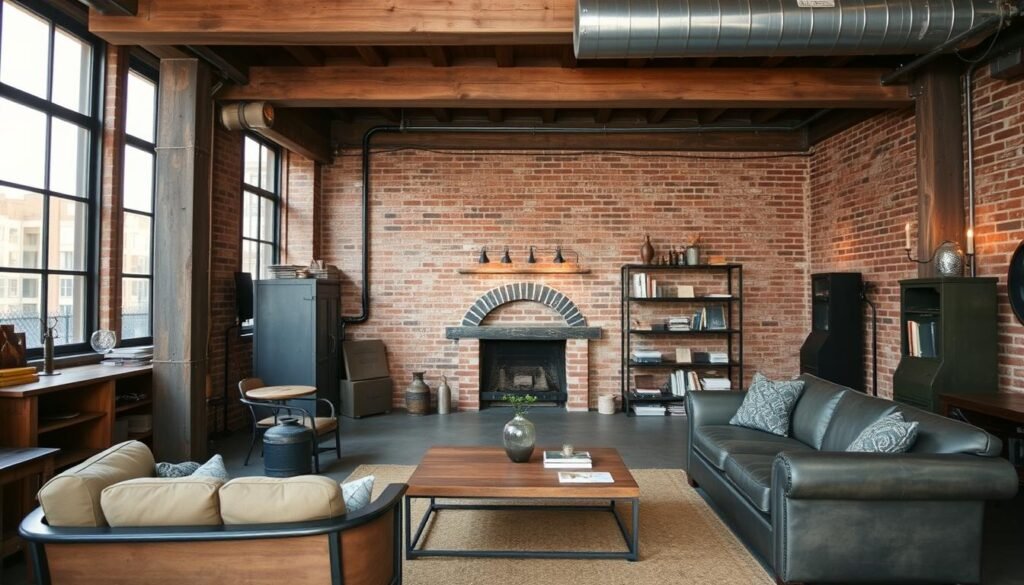
Mixing Modern and Repurposed Elements
In the world of industrial decor, blending modern and repurposed elements is key. This mix creates a space that’s both harmonious and striking. It celebrates the past’s charm while embracing today’s convenience and function.
Balance and Proportion Tips
Finding the right balance between old and new is crucial. Choose furniture and decor that match in scale and proportion. Mixing metal finishes adds a nice contrast of lines and curves. Refreshing old seating with new batting and springs adds comfort without losing its vintage appeal.
Using the same color palette for different styles and periods can tie everything together. Try mixing wood finishes and metals to create a seamless look. This blend can effortlessly connect your pieces.
Creating Focal Points
To make a statement, use large-scale antique pieces like vintage furniture or mirrors. These items can anchor the room, making it stand out. Or, start with smaller antique pieces like end tables or stools to introduce a vintage touch gently.
When repurposing antique furniture, keep its original details and patina intact. Refinishing can update its look without losing its historical and aesthetic value. This way, you celebrate the past while enjoying modern benefits.
“Vintage meets modern design allows homeowners to create personalized, timeless havens with a rich tapestry of textures, colors, and styles.”
By mixing upcycled, eco-friendly crafts and sustainable design with modern pieces, you create a unique space. This space reflects your style and celebrates creative reuse.
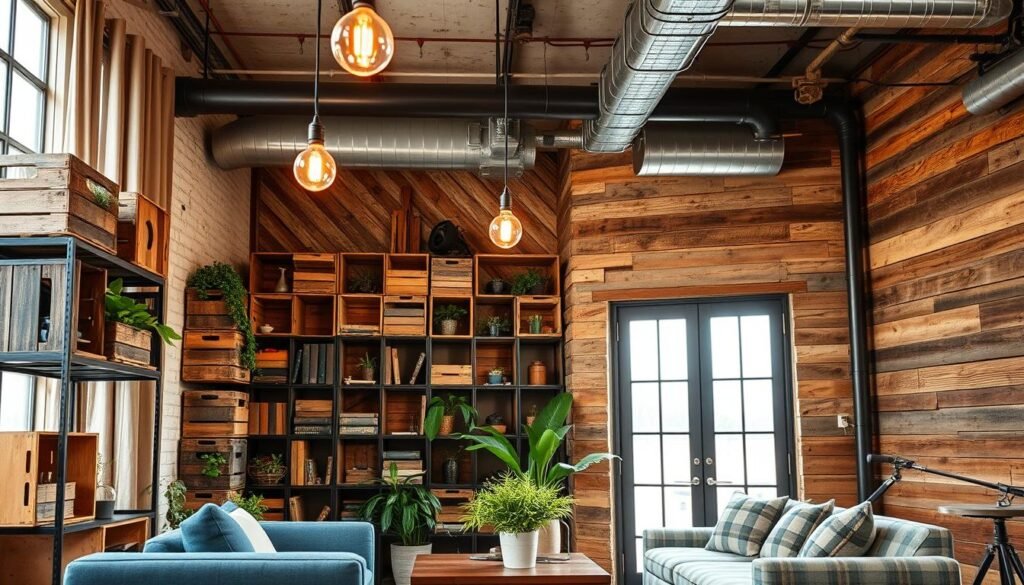
Conclusion
We’ve looked into the world of repurposed materials in industrial decor. We’ve seen how it started and how to make unique items. This sustainable way not only makes your home stylish but also helps the environment.
Creating a industrial decor space is all about being creative and patient. It’s about seeing the potential in things you might otherwise throw away.
Now, it’s your turn to start your upcycling adventure. Turn your home into a stylish, industrial-chic place. Using repurposed materials saves money and helps the planet. It’s a step towards a more sustainable life.
Get ready to show off your design skills. Make a space that’s truly yours. It will be a place that reflects your unique style.
The world of repurposed materials and industrial decor is full of possibilities. Take on the challenge, be creative, and enjoy making your home a beautiful, eco-friendly space. Happy decorating!
ALSO READ: Key Elements of Industrial Style Decor | Design Guide
Frequently Asked Questions
What is industrial decor, and how does it incorporate repurposed materials?
Industrial decor uses old items, like factory parts and machinery, to make beautiful spaces. It turns old materials into decor, saving resources and reducing waste.
What are some essential tools and materials needed for upcycling projects?
You’ll need sanders, paint brushes, and drills. Look for salvaged wood, metal, and vintage parts. Find these in thrift stores, salvage yards, and your home.
How can I properly prepare and integrate repurposed materials into modern interiors?
Pick quality items that last. Clean and prepare them safely. This way, they fit well with your decor.
What are some creative ways to transform vintage industrial elements into decor?
You can make coffee tables from old machinery parts. Turn signs into art and make lights from salvaged materials. The options are endless.
How can I use reclaimed wood in my industrial-inspired space?
Reclaimed wood is great for industrial decor. Use it for furniture, wall features, and accents. Find it in barns or old pallets.
What techniques can I use to integrate metal elements into my industrial decor?
Clean and restore old metal. Use it for hardware, fixtures, and details. Mixing metals adds interest to your space.
How can I use upcycled textiles and fabrics in my industrial-inspired home?
Use old grain sacks and flags for upholstery and pillows. Clean and restore these textiles to give them new life.
What color palette and finishes work best for industrial decor using repurposed materials?
Choose finishes that match the materials and keep the industrial look. Distressing and aging help new items fit with old ones. Add color for interest.

